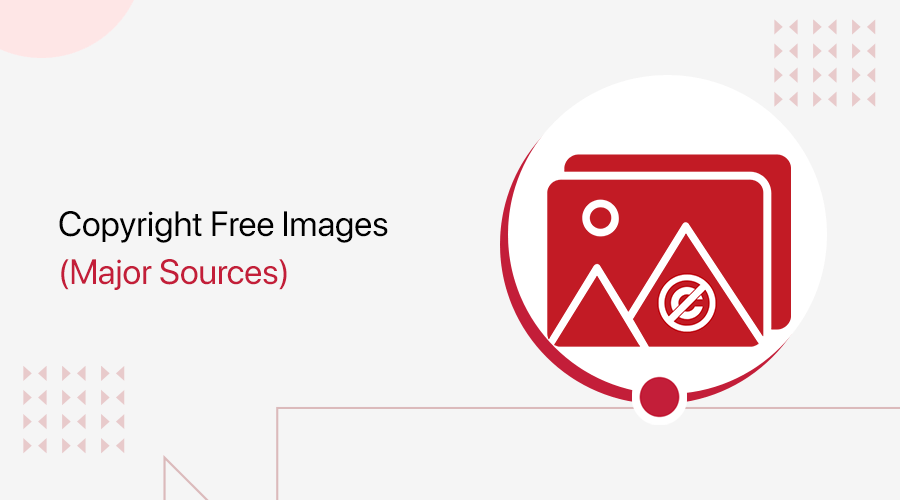
Have you ever wondered how to find copyright free images for your blog without getting into legal trouble? If yes, then you’ve come to the right place!
We all know images are an essential part of successful blogging. Also, perfect images that enhance your content can boost your blog post. Not only that, it creates connections and simplifies complex information.
But, finding the perfect images for your blog can be challenging. Especially when you must ensure they’re both high-quality and legally safe to use. Because using copyrighted images without permission can lead to serious consequences.
Luckily, there are plenty of resources that offer copyright free and royalty free images. These images can enhance your blog posts, making them more visually appealing and engaging for your readers.
So, in this guide, we’ll explore how to find copyright free images.
Let’s dive in!
Video Tutorial: How to Find Copyright Free and Royalty Free Images for Your Blog?
Would you prefer to watch a tutorial video on YouTube instead? It’s right here!
Meanwhile, continue reading to the bottom if you still like the comprehensive article.
Why Use Copyright Free and Royalty Free Images for Blogs?
Have you ever scrolled through a blog and noticed how the pictures caught your eye? Do you want the same for your site? But how?
The answer is copyright free images. Using copyright-free and royalty-free images can make your blog more attractive without legal obligations.
Here’s why it’s a great idea:
- No Legal Worries: You don’t have to worry about breaking any rules or getting in trouble for using someone else’s work without permission.
- Cost Effective: Most of these images are free to use, which means you can add professional-looking visuals to your blog without spending money.
- Wide Selection: There are thousands of images available online, covering almost every topic imaginable.
- Versatility: You can use these images for different purposes, whether it’s for a personal blog, a business website, or social media posts. They often come with flexible usage rights that allow for both personal and commercial use.
- Enhanced Engagement: Readers are more likely to stay on your blog and read your content if it looks appealing. Images can break up text and make your posts more enjoyable to read.
Don’t you think it’s a win-win situation?
Understanding Stock Image Licenses
Before we get into the list of sources for copyright free and royalty free images, let’s take a quick look at some of the stock image licenses.
1. Copyright Free
Copyright Free is a term that you hear a lot, but it’s important to understand its true meaning. Simply understand that copyright free images are those that aren’t protected by copyright laws. This means anyone can use them without needing to get permission from the creator.
That’s why it’s a great choice for a blogger, a small business owner, a student, or even a large corporation. You can use them in blog posts, social media updates, marketing materials, and more.
The best part? You don’t have to worry about paying fees or getting permission.
However, always double-check the source to ensure the image is truly copyright free.
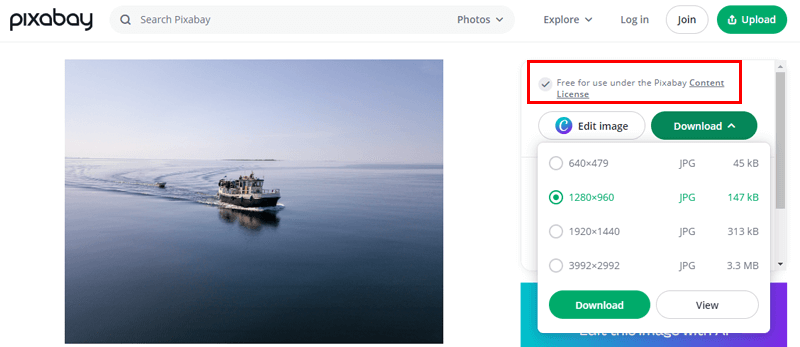
A great example of a website offering copyright free images is Pixabay. There, you’ll find a huge collection of images that you can use for free.
2. Royalty Free
You should never confuse royalty free with copyright free images. Because with royalty free you pay once to use the image as many times as you want. There’s no need to pay the creator every time you use the image.
Although you pay for the images, it’s still a cost-effective solution for many bloggers. Besides, anyone can use royalty free images which are perfect for both personal and commercial use.
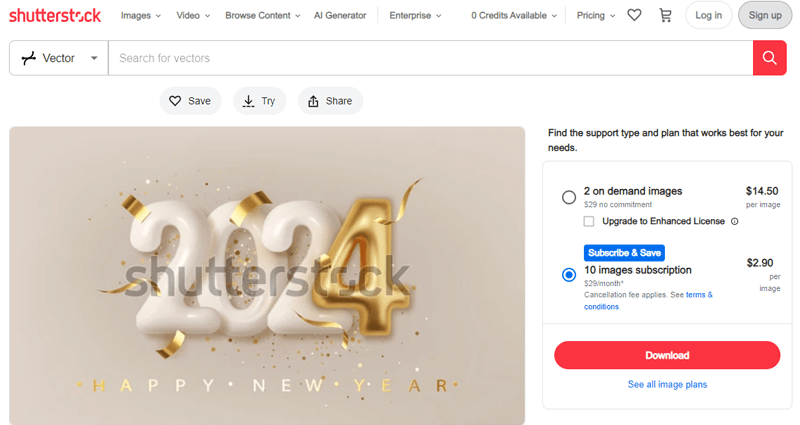
One of the best places to find royalty free images is Shutterstock. You don’t need to worry about paying royalties each time you use their images. Just pay once to download what you need and use it for your blog posts, social media, or any other projects.
3. Attribution Required
Have you come across images labeled as “attribution required” and wondered what that means? This type of license allows you to use the image for free, but you must give credit to the creator. It’s like saying a public “thank you” to the artist for letting you use their work.
Anyone can use images with an attribution-required license. The key is to make sure you give proper credit to the creator, usually by mentioning their name and the source of the image.
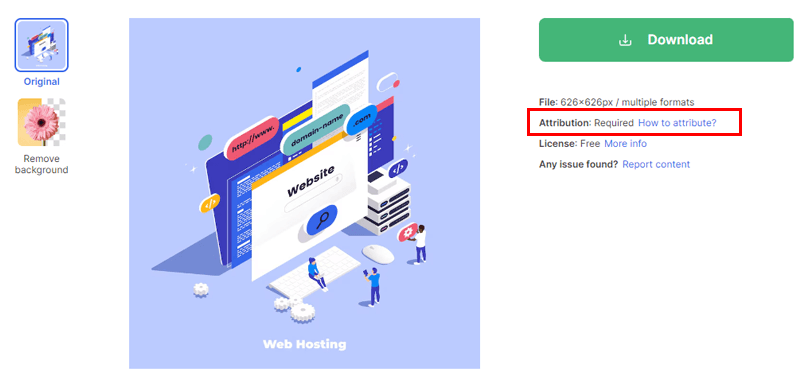
Freepik is a popular website that offers images and illustrations with an attribution required license. To give credit, you can include an attribution line, such as “Designed by Freepik” on the final product or design, whether it’s a digital or a physical product.
Usually, the best place to add the attribution line is next to the image. But there are other alternatives, like placing it in the footer of your website, blog, or newsletter.
4. General Public License (GPL)
General Public License is a type of license mainly used for software. But it can also apply to other types of creative works. This type of license allows you to use, modify, and distribute the work freely.
And any changes you make must also be shared under the same GPL license.
Why?
- This ensures that everyone benefits from improvements and modifications.
- Also, the community continues to grow and benefit from everyone’s contributions.
Besides, whether you’re a developer, blogger, educator, or hobbyist, you can use and adapt GPL-licensed works.
A well-known example of a website using the GPL is WordPress.org. This site allows everyone to use the photos anywhere, for any purpose, without the need for permission, attribution, or payment.
However, you cannot claim ownership or authorship of any photos in the WordPress Photo Directory.
5. Creative Commons Licenses (CC)
Next, we have a Creative Common License. You might have come across images and other works with a “CC” label many times. Well, these types of licenses permit certain uses of copyrighted materials by the public.
So, you can share, and sometimes even modify these works without asking for permission, as long as you follow the license terms. This could mean giving credit to the creator or not using the work for commercial purposes.
Besides, the CC license comes paired with different letters. Let’s see what all that means.
| Different CC Licenses | Description |
| CC BY (Attribution) | Lets you use, share, and modify the work as long as you give credit to the original creator. It’s the most flexible type of CC license. |
| CC BY-SA (Attribution-ShareAlike) | You can use, share, and modify the work, but any new work you create must be shared under the same license. This is similar to the GPL for software. |
| CC BY-ND (Attribution-NoDerivs) | Allows you to use and share the work, but you cannot modify it. You must also give credit to the creator. |
| CC BY-NC (Attribution-NonCommercial) | You can use, share, and modify the work for non-commercial purposes only, and you must credit the creator. |
| CC BY-NC-SA (Attribution-NonCommercial-ShareAlike) | Lets you use, share, and modify the work for non-commercial purposes. But you must credit the creator and share any new work under the same license. |
| CC BY-NC-ND (Attribution-NonCommercial-NoDerivs) | This is the most restrictive CC license. You can use and share the work for non-commercial purposes only, without modifying it, and you must give credit to the creator. |
You can check the Creative Commons website for more detailed information.
For example, Flickr allows photographers to choose from various CC licenses for their photos.
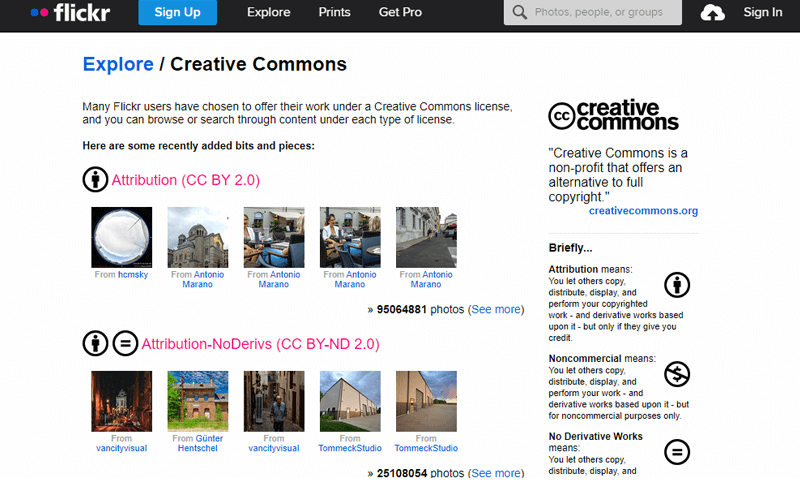
So you can find images under different CC licenses and use them for free as long as you follow the license terms.
6. Public Domain (CCO)
Ever wondered what it means when an image is in the public domain? It means the rights of its creators have expired, and the image is available for everyone to use.
Additionally, you can use these images,
- Without paying any fees.
- Also without having to credit the creator.
This makes public domain images a fantastic resource for bloggers and content creators. Plus you can use it for both personal and commercial use.
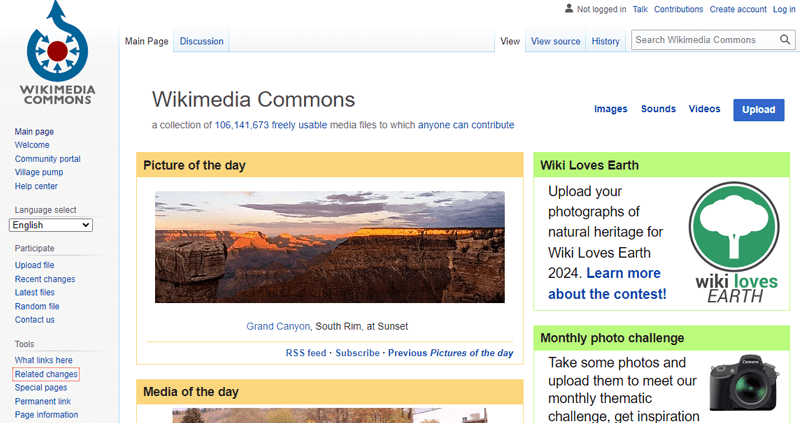
For example, Wikimedia Commons is a site that has a collection of images and is free to use. You can find photos, illustrations, and other media files that you can download and use without any restrictions.
7. Rights Managed (RM) License
Rights Managed (RM) licenses involve the most restrictions among image licenses. When you use an RM-licensed image, you must get approval for your specific use. This includes details like where you’ll use the image, the size of your print run, and how long you’ll use it.
Moreover, this license is typically used for editorial and commercial use. This includes magazines, newspapers, ad agencies, and companies creating annual reports. Because of the restrictions, images are ideal for projects with exclusive and high-quality visuals.
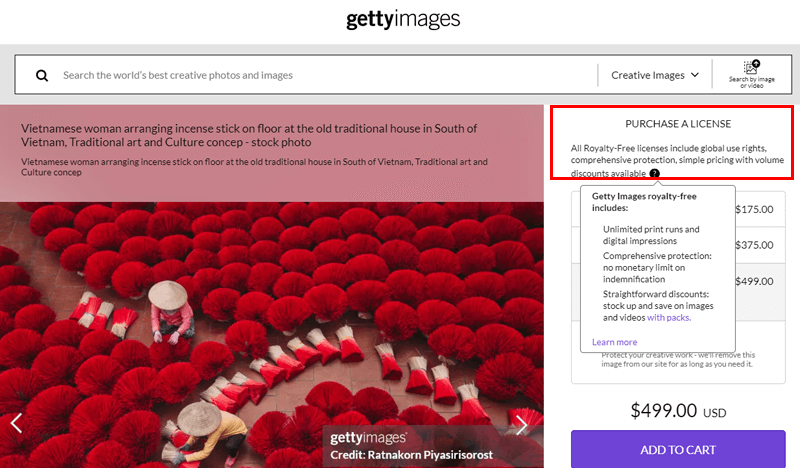
A good example of a website offering Rights Managed licenses is Getty Images. They provide a wide range of images under RM licenses, which can be exclusive or non-exclusive.
To be exact,
- An exclusive RM license means only one person can use the image at a time, giving them sole rights.
- A non-exclusive RM license allows multiple people to use the image, making it cheaper.
8. Editorial Use Only
Lastly, the Editorial Use Only license! This type of license restricts the use of images for non-commercial purposes. So, you can’t use these images to make money, which means no advertising or promotional work.
Editorial Use Only images are perfect for journalists, bloggers, and educators.
Where can you use it?
- Newspapers
- Magazine articles
- Books
- Websites for descriptive purposes.
As well as us on non-commercial presentations, and documentaries or news broadcasts.
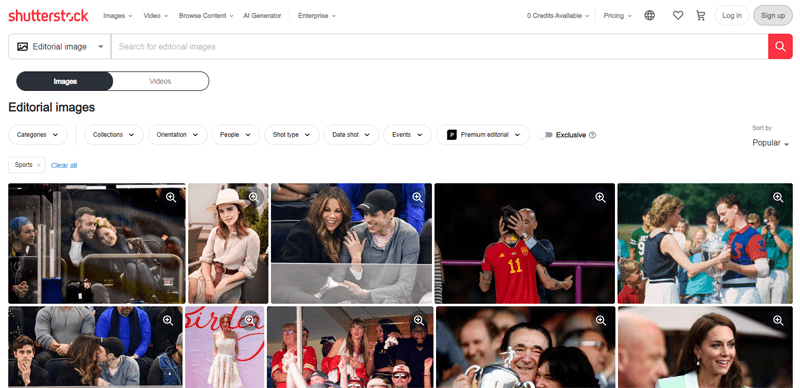
Shutterstock is a great example website that provides images under the Editorial Use Only license. You can use these images anywhere. Just remember, don’t use it on commercial websites, in advertisements, product packaging, or any other commercial materials.
So now you get it, understanding stock image licenses is crucial for using images legally and ethically. This ensures you make the most of these valuable resources without running into legal issues.
Having said that, let’s take a look at some of the popular sites to find copyright free and royalty free images.
Where to Find Copyright Free and Royalty Free Images
Below we’ve listed some of the popular websites to find copyright free images for your blog.
1. WordPress.org Photos
Looking for a place to find great images for your blog? Check out WordPress.org Photos. This platform offers a wide range of high-quality, copyright-free images perfect for your WordPress site.
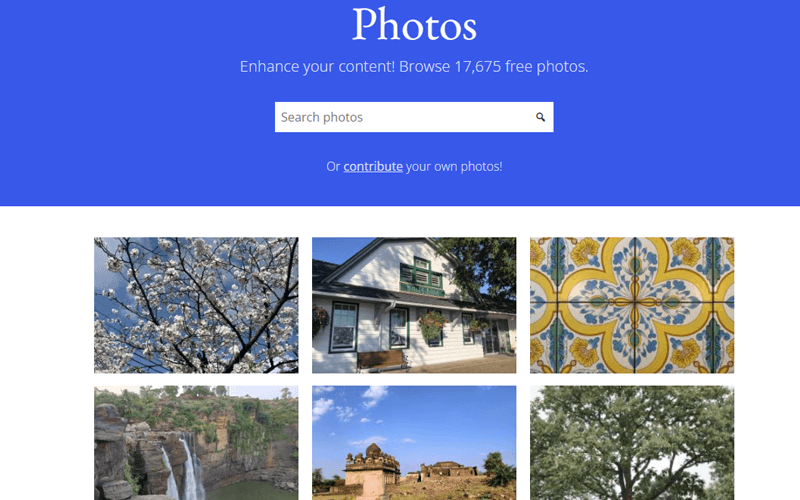
On the WordPress.org photo directory, you can find a vast collection of beautiful, free stock photos. These images are perfect for any type of blog or website. Besides, all photos are free to use, both for personal and commercial projects.
Moreover, using WordPress.org Photos is super easy. Simply browse through the categories or use the search bar to find the perfect image for your blog. Once you find an image you like, click to download it. You don’t need to worry about attribution!
2. Unsplash
Unsplash is a popular website for downloading over 1,000,000+ royalty-free images. Known for its high-quality, professional-grade photos, it’s a go-to resource for bloggers, designers, and marketers seeking stunning visuals.
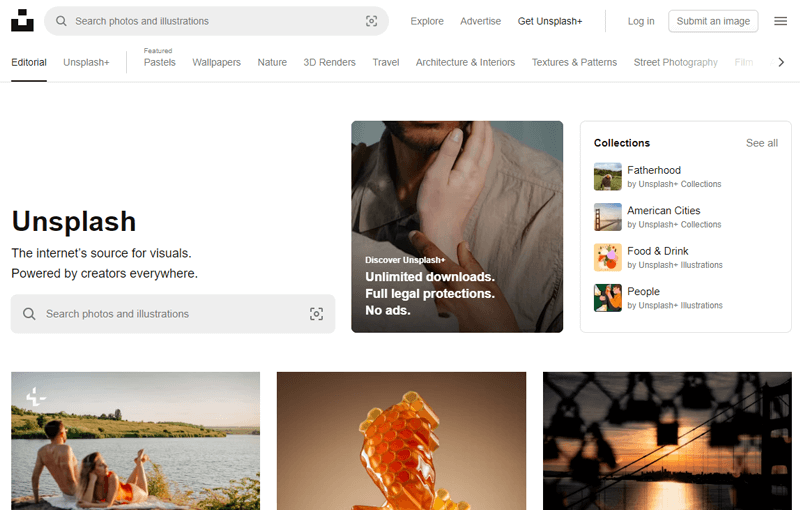
On Unsplash, you’ll find various images categorized as animals, apps and technology, events, feelings, food, travel, and more. Each category is filled with diverse and vibrant images that can add significant value to your blog content.
Additionally, Unsplash offers a feature to like the images you’re downloading and add them to collections for easy access and organization.
Also, you can use Unsplash Chrome Extension, to see a random Unsplash image in the background each time you open a new tab. Plus, download these images directly to your computer from the new tab.
3. Vecteezy
Looking for a website with stunning visuals for your blog? With an impressive 4.9 out of 5-star rating on Trustpilot, Vecteezy is one of the best websites for downloading both free and paid images.
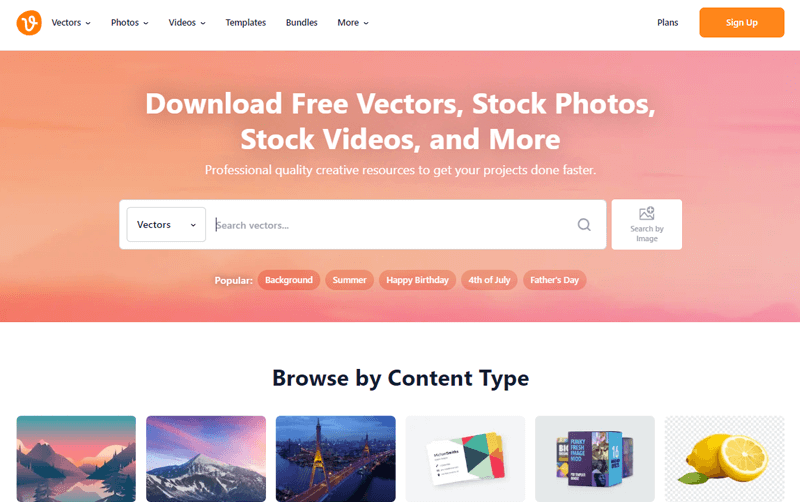
Here, you’ll discover a rich collection of images, including vectors, photos, videos, templates, bundles, PNGs, infographics, etc. Moreover, you can search alphabetically or filter your search results by best match, free license, color, orientation, etc.
Thanks to Vecteezy’s licensing, you can use these images for both commercial and non-commercial purposes without any hassle. However, free files have usage limitations and you need to provide attribution to Vecteezy.
4. Undraw
Undraw is the perfect place to find fresh and modern illustrations for your blog. This website is a fantastic resource that offers a plethora of illustrations that are versatile and easy to use.
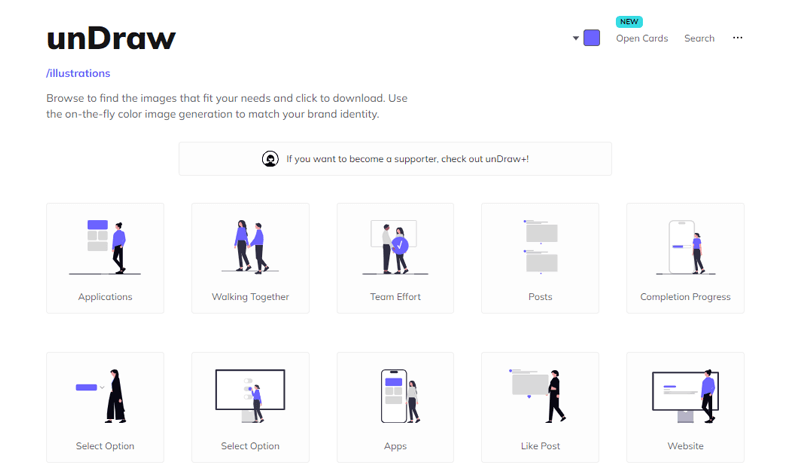
You can simply click the illustration of your choice and download it. Moreover, its ‘on-the-fly color generation’ feature lets you customize the colors of the images to align perfectly with your brand identity. Also, choose between downloading illustrations in SVG or PNG formats.
Get creative with its Open Card feature! Create your own cards or use the ones created by others, just like the illustrations. You can easily change the text on the cards to fit your message and download them for use.
5. Open Doodles
Another fantastic resource on the list is Open Doodles. This site offers a playful and unique style with a free set of open-source illustrations for your blog.
You can download illustrations in both SVG and PNG formats. Want to tweak the illustrations? Open Doodles allows you to edit each illustration with Blush.
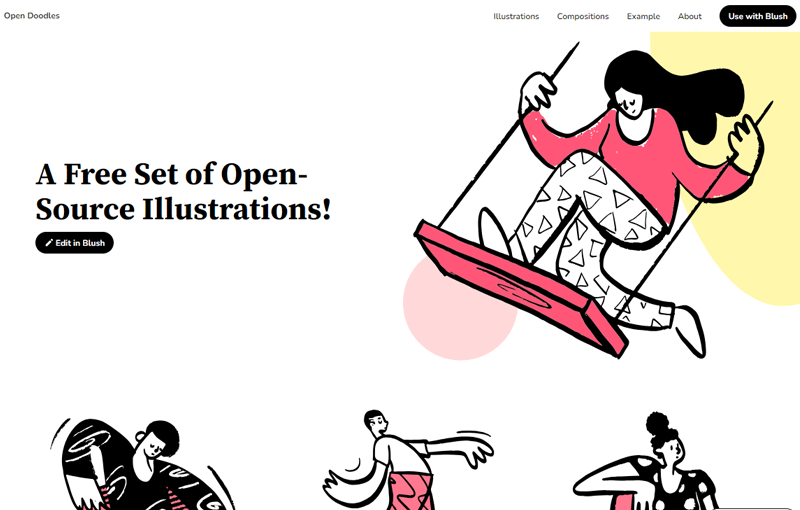
There, you can change the background color of the illustrations. Or choose other illustrations by the same artist, making it easy to create a matching look for your blog.
If you need more, then upgrade to the pro plan that provides unlimited downloads, save unlimited designs for reuse, and access to over 10,000 illustrations. The premium plan starts at $12 per month, billed yearly.
6. Pexels
If you’re on the hunt for high-quality visuals to elevate your blog, then Pexels is your go-to resource. It offers the best free stock photos, royalty-free images, and videos.
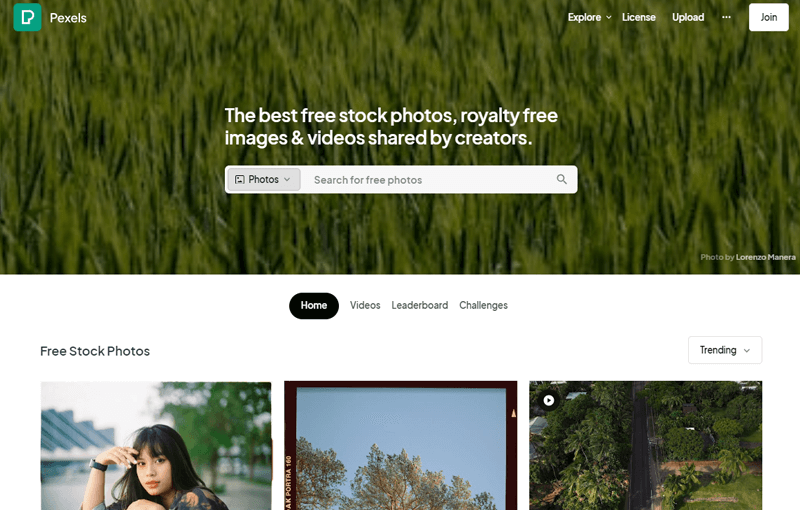
Besides, all photos and videos on Pexels can be downloaded and used for free. Get everything you need for a blog post, social media, or a marketing campaign. Also, you can modify the photos and videos to fit your needs.
The best art, you don’t need to give credit to the photographer or Pexel. This means you can use the visuals without worrying about complicated licensing issues.
But remember not to sell copies of a photo or video (e.g., as a poster, print, or on a physical product) without modifying it first.
7. Pixabay
Pixabay is your one-stop shop for stunning royalty-free images, videos, and music. With over 4.5 million high-quality stock assets available, it’s easy to find the perfect visuals to boost your content.
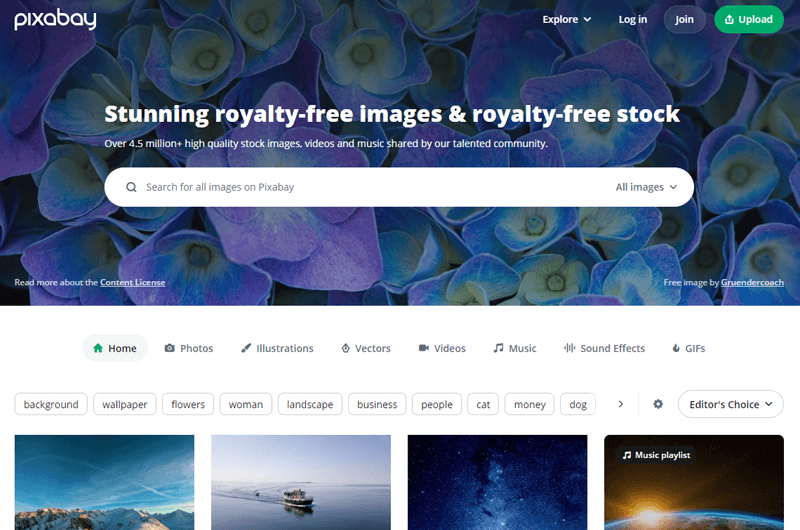
Moreover, for a more refined browsing experience, you can turn on safe search and hide AI-generated images. Also, choose images through the Editor’s Choice, latest, and trending sections. Or explore specific categories like wallpaper, flower, women, business, etc.
Furthermore, you can use the search bar to type in your designed keywords. And then filter your search by selecting options like photos, illustrations, vectors, and more.
Besides, Pixabay allows you to use images without attributing the author. While you can modify the content, you cannot sell or distribute it on a standalone basis.
Note: If the content contains recognizable trademarks, logos, or brands, then it cannot be used for commercial purposes.
8. ManyPixels
Looking for a way to make your blog posts pop with vibrant and unique illustrations? ManyPixels is the perfect solution! With a vast collection of free illustrations, it helps you power up your designs and boost your content effortlessly.
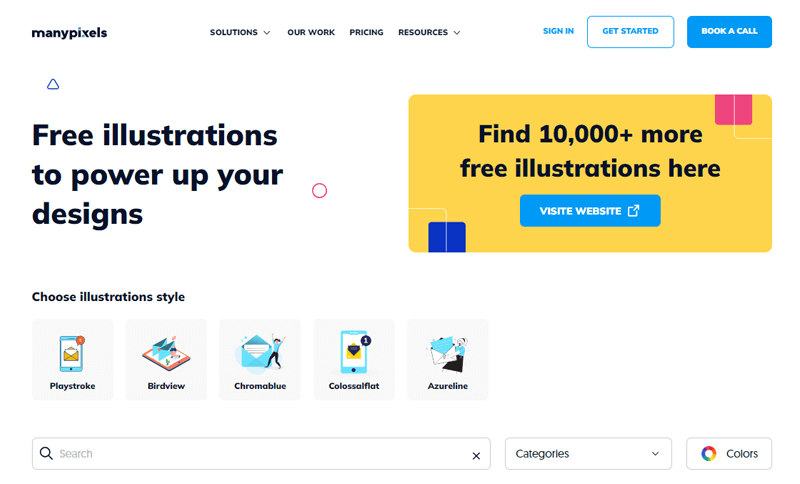
It allows you to choose from a variety of illustration styles to match your blog’s aesthetic. Whether you prefer Playstroke, Birdview, Chromablue, Colossalflat, or Azureline.
Additionally, you can personalize illustrations by choosing a color or adding your custom color code. Then download the illustration in SVG or PNG formats.
Moreover, you can use the illustrations in any project. Whether commercial or personal, without the need for attribution or any costs.
Note: Remember not to replicate ManyPixels, redistribute the illustrations in packs, or create integrations for them.
9. DrawKit
DrawKit offers high-quality, creative images to make your vlog post shine. It’s a reliable source for all things creative. As it offers a fantastic collection of hand-drawn 2D & 3D illustrations, icons, mockups, and animations that are perfect for your next project.
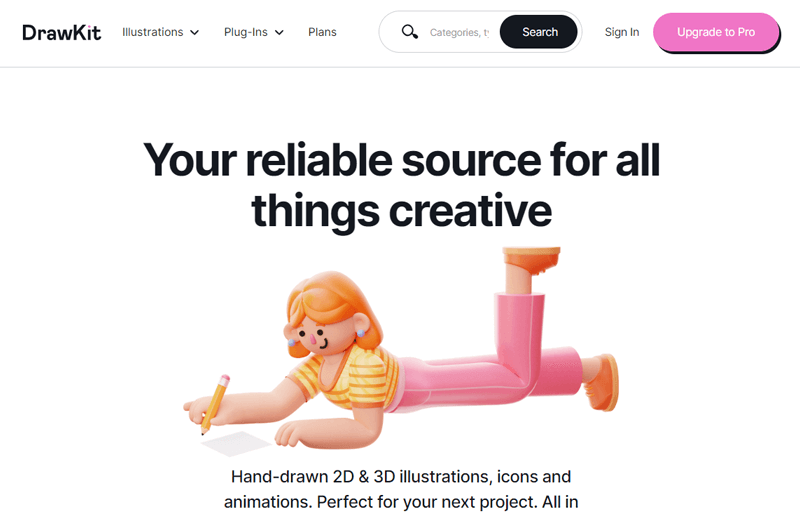
You can browse through a wide array of categories such as environment, startups, digital marketing, working, education, and more. Making it easy to find the perfect illustration to complement your content.
Besides, all icons and illustrations on DrawKit are available for both commercial and non-commercial use. You can use them in your print and digital products without any restrictions. Also, don’t need to provide attributions.
10. StockSnap
StockSnap is a one-stop shop for beautiful free stock photos that are free from copyright restrictions. With a wide range of images to choose from, it’s sure to have just what you need to make your blog posts stand out.
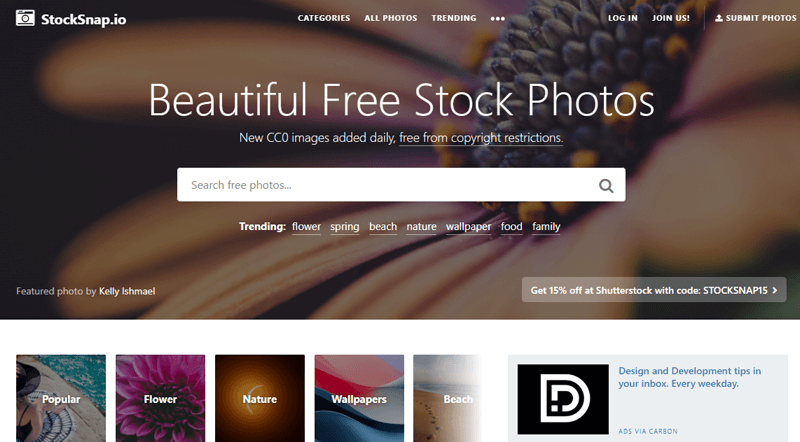
You can easily navigate through the collection by browsing popular categories like flowers, nature, wallpapers, beach scenes, business shots, and more. Choose the one you like and download it.
Besides, this site uses a Creative Commons CC0 license. This means you have the freedom to download, publish, revise, copy, alter, and share the images for both personal and commercial purposes.
11. PickupImage
PickupImage is another website that helps you boost your blog with stunning visuals. It offers free stock images and public domain photos. So, you can make this site your go-to destination for high-resolution pictures.
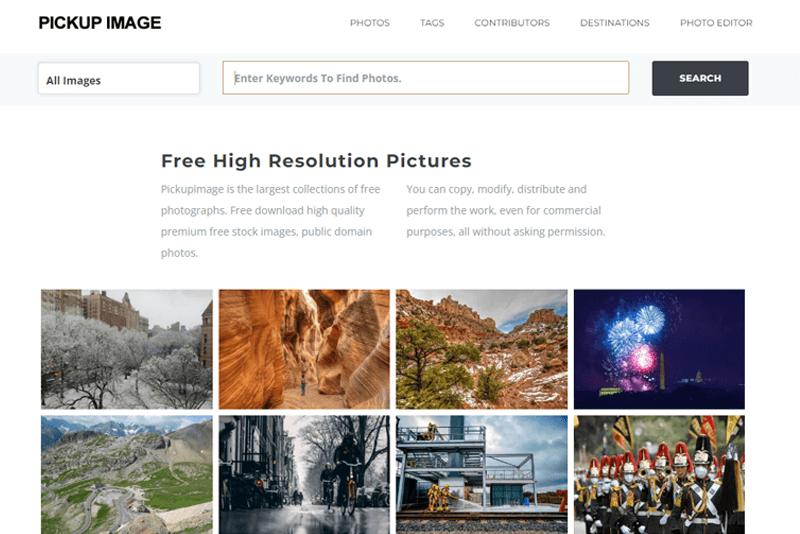
Besides, you have the freedom to copy, modify, distribute, and perform the work, even for commercial purposes, all without asking permission. Also, it doesn’t require attribution, giving you even more freedom to use the images.
While downloading, you can choose the quality and size of the images to suit your specific needs. Additionally, it allows you to edit the images directly on the platform. So, add filters, resize, crop, add text, stickers, frames, etc to make the images truly your own.
12. SplitShire
Nest is SplitShire, a collection of beautiful and exclusive stock photos to enhance your blog. Each image is carefully added to ensure maximum impact for your blog posts.
Here, you’ll enjoy instant access to a private collection of free stock photos, stock videos, and high-resolution images. That too is available for personal and commercial use. You can use it on your blog, social media, advertising campaigns, mobile apps, etc.
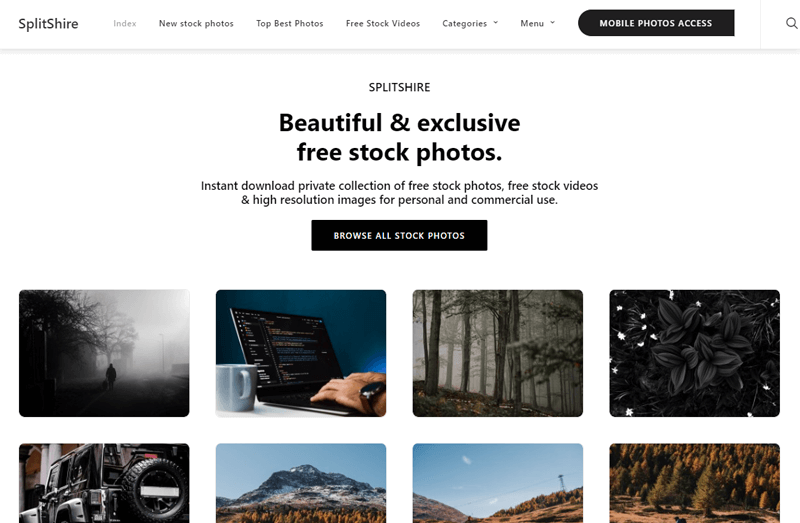
Moreover, you can download any free stock photo or video uploaded on SplitShire. So, use it with no worries about copyright or attribution.
If you’re a developer, then you’ll love that all the images can be included in your final product to sell. Whether you’re creating templates, Photoshop files, video projects, graphic templates, mockups, or any other digital product.
13. LibreShot
LibreShot offers a collection of free stock photos personally created by the website’s author, Martin. Each photo is carefully selected to ensure quality and relevance for your blog. And, you can download photos for free.
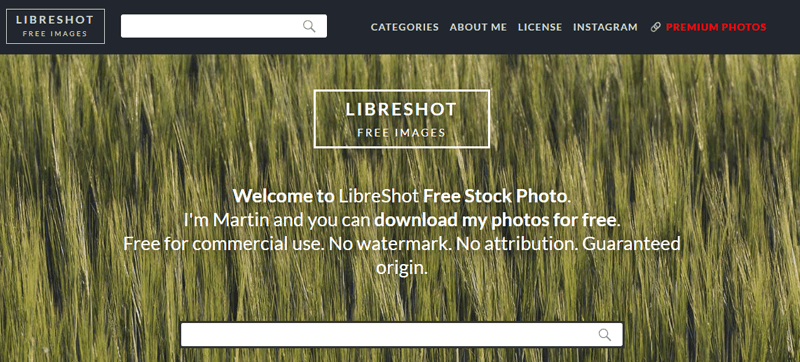
Moreover, explore a variety of categories including business, architecture, nature, close-up, people, and technology. And, all photos are free for commercial use, with no watermarks and guaranteed origin.
Besides, photos on LibreShot are licensed using CC0. Meaning you can use them without attribution. This gives you the freedom to use the images without worrying about legal issues.
Note: The only condition is no bulk downloading and using photos of LibreShot on similar sites like stock photo websites.
14. Skitterphoto
Skitterphoto is not just a photo gallery, it’s a community hub. Here you can find images, showcase, and share public domain photos. So browse their categories of images or use keywords to find the perfect match for your blog.
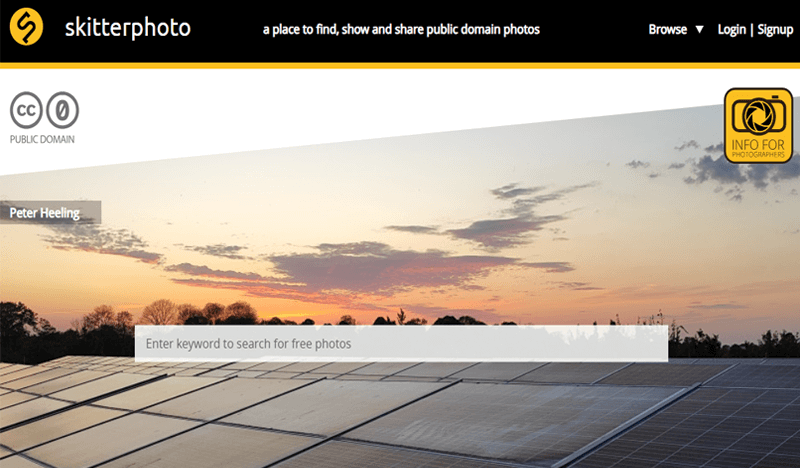
At Skitterphoto, you’ll discover a plethora of photos that are free to use for any purpose. This means you can download, edit, and even use the photos commercially without any restrictions.
And, if you’re a photographer, then join Skitterphoto and share your best photo. Your photos may even be selected to be featured on the Skitterphoto website and social media channels.
15. Freerange Stock
Last but not least, we have Freerange Stock, which offers high-quality, free stock images to enhance your blog. Whether you need AI-generated images, CC0 images, editorial and news photos, or shots of animals & insects, etc, Freerange Stock has you covered.
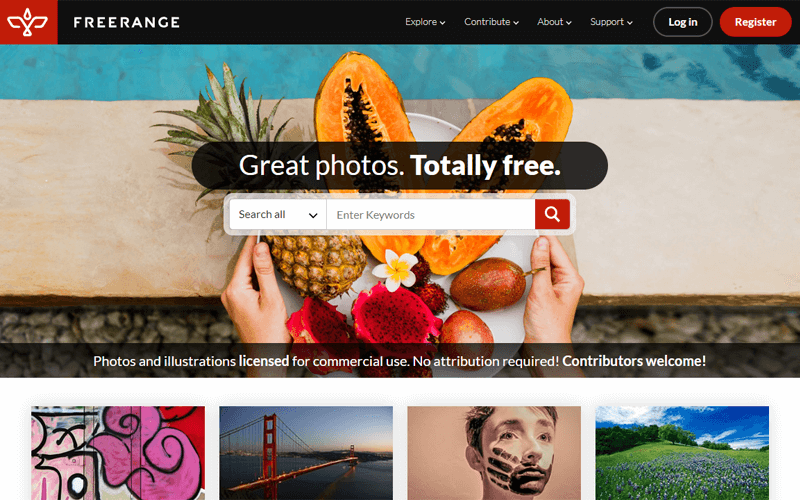
Additionally, you can use images for nearly any purpose, whether commercial or non-commercial, without attribution. This gives you the freedom to add images to your blog posts without worrying about licensing restrictions.
However, you cannot sell, redistribute, or relicense the images. And you cannot sell products that derive their primary value from the image. With these guidelines in mind, you’re free to explore and utilize the fantastic images available
How to Use Free Images Legally and Ethically?
Now that you know where and how to find copyright free images for your blog. Let’s take a look at some simple guidelines to ensure that you’re using images responsibly.
- Always check the usage rights and licenses of images before using them. If an image is copyrighted, you can’t use it without permission from the owner.
- Always assume an image is copyrighted unless it’s explicitly stated otherwise.
- When in doubt, choose images from sources that offer clear copyright-free or royalty-free licenses.
- When required, always give credit to the image creator. This usually involves including the creator’s name and a link to the source.
- Avoid using images that contain recognizable trademarks or copyrighted material without permission.
- Some licenses allow modifications, while others don’t. Check the license to see if you can modify the image.
- If your blog makes money, or you plan to use the images for commercial purposes, ensure the license allows commercial use.
- Creating your images is a great way to ensure you have full control over their use.
Besides, if you’re willing to spend some money, stock photo websites like Shutterstock and Adobe Stock offer images with clear licensing options. These images come with a legal guarantee, which can be reassuring for commercial use.
Make sure to keep a record of where you got each image and the license that applies to it. This helps if there’s ever a dispute about your image use.
Frequently Asked Questions (FAQs)
Now that you know everything about how to find copyright-free images for your blog, let’s answer some of your common questions.
1. Should I watermark my blog photos?
Watermarking your blog photos can discourage some forms of unauthorized use. But, it can also distract from the content and make the photo less appealing. So, think about balancing between protection and presentation before deciding to watermark.
2. How to protect your images from unauthorized copying?
You can protect images by adding a copyright note, not letting people right-click to save them. But remember, none of these ways are perfect, so keep an eye out for any misuse.
3. How can I make copyright-free images?
You can make copyright-free images by taking your pictures, using images that anyone can use, or using images from places that let you use them for free.
4. Are copyright-free images actually copyright-free?
Yes, usually copyright-free images mean you can use them without worrying about copyright rules. But always check the rules that come with the image to be sure you’re using it right.
Conclusion
So, that’s all for now!
In this article, we’ve looked at how to find copyright free images for your blog. We hope this article helped you find the perfect copyright free images for your blog.
Please feel free to comment below if you have any further queries regarding how to find copyright free images. We’ll do our best to respond as soon as we can.
Also, let us know which site you’re using to find copyright free images for your blog. You can share your top tips and tricks in the comments section below.
Besides that, we’d also love to hear your thoughts on this article. So, please feel free to comment on any queries or suggestions below.
You may also like our guide on how to find out what website builder was used and the best WordPress image optimizer plugins.
Follow us on Facebook and Twitter for more articles like these. Also, if you liked this article, then share it with your friends and colleagues.


